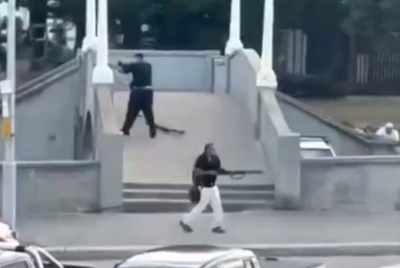Joint Exercises: Confronting the Fragmented Face of Modern Organised Crime
Multinational law enforcement drills build agility against evolving global criminal networks.

Criminal networks are not static; they refine, adapt and diversify at a pace that increasingly tests the limits of traditional law enforcement. The last decade has seen a profound shift in how organised crime functions. Where once hierarchical cartels and syndicates dominated, today's networks resemble fluid supply chains, built on digital connectivity and commercial-style agility.
Their illicit economies stretch from cyber-fraud rings run out of major capitals to small, compartmentalised cells smuggling narcotics through shifting maritime routes. These are less 'families' than franchises of crime, able to reconfigure operations swiftly to evade detection. Tackling these actors demands a fundamentally reframing of law enforcement approaches.
Law enforcement agencies face growing complexity in responding to this evolution. In the digital domain, criminal innovation outpaces regulation, with ransomware operations generating an estimated £18 billion in global losses in 2023 alone. The physical and virtual have fused: encrypted messaging services, cryptocurrencies, and cheap logistics systems permit illicit trade at an arm's length. Traffickers now source synthetic drug precursors and illegal firearms as easily as legitimate businesses procure materials – and do so across continents.
Such fragmentation demands that our response also evolve. National agencies, working in isolation, can no longer manage crime that flows seamlessly across jurisdictions. In the European Union, for example, the dismantling of a multinational cocaine trafficking network in 2024 required investigators from seven countries to share intelligence in real time. This effort, coordinated through Europol, removed four tonnes of cocaine and 40 senior operatives from circulation. The lesson is clear: operational interoperability is no longer a luxury, but a necessity.
That is why joint, live multinational exercises have become one of the most critical elements of readiness. They move cooperation from the conference hall to the command room – and then out into the field. Table-top scenarios alone cannot replicate the pressures of a complex, rapidly changing criminal event that draws in multiple law enforcement traditions, legal systems and languages. Exercises that simulate multi-agency responses to cyberattacks, terror threats or coordinated smuggling networks refine habits of communication and decision-making that are indispensable in real crises.
This principle is evident in joint, live multinational exercises that test readiness under pressure. The most recent of these, ISALEX 3.0, organised in Bahrain this week by the International Security Alliance (ISA), brought together 25 officers drawn from key divisions within its 11 member countries' law enforcement agencies. Unlike other exercises, ISALEX is fully immersive, combining in-person planning with high-intensity tactical deployments, emulating a genuine, pressurised scenario.
Each participant entered the week-long scenario - the third of its kind - without prior knowledge, ensuring reactions mirrored the unpredictability of real-world operations. In addition, regular injects, enhanced by artificial intelligence, forced participants to pivot regularly and adapt in real time. These included inbound media requests, and simulated drops of new information.
In order to assimilate participants and encourage collaboration, the exercise took place in a fictional country, wherein all officers were members of a singular law enforcement body. The exercise began with an intelligence briefing indicating activity by rival gangs engaged in human trafficking along the docks. As the operation unfolded, it escalated rapidly into a hostage crisis. Subsequent searches revealed not only trafficking evidence but also fragments of a missile, pointing to a third, clandestine group planning a terrorist attack. The exercise concluded dramatically, with a full tactical operation in which divers were physically dispatched to locate a final missing missile component beneath a vessel. Throughout, the scenario tested decision-making, digital investigation tools and cross-agency coordination, providing valuable insights participants could apply within their domestic operational contexts.
For the UAE Ministry of Interior, ISALEX 3.0 illustrates the practical value of international cooperation. Shared operational environments allow officers to test decision-making and coordination under conditions that mirror real-world pressures. For participants, such experiences strengthen professional networks and improve the understanding of how counterpart agencies operate - a foundation for rapid, effective collaboration when genuine crises arise.
Modern criminal networks are increasingly adaptive, fragmented and global. The speed at which technology is changing amplifies this challenge, with artificial intelligence, cryptocurrencies and synthetic economies enabling new forms of exploitation and concealment. Law enforcement agencies cannot afford to lag behind; they must be as agile and interconnected as the threats they face.
The ISA, co-led by the UAE and France, continues to provide a platform where these capabilities can be developed collectively. By fostering professional trust, refining information-sharing mechanisms and aligning operational approaches, the Alliance helps ensure that national responses can integrate seamlessly when required. Such cooperation strengthens deterrence and readiness across borders without diminishing domestic sovereignty or accountability.
The threats ahead will demand more of this kind of disciplined partnership. The misuse of emerging technologies, the growth of illicit financial systems and the weaponisation of global supply chains will require responses that are fast, coordinated and legally sound. Preparedness must therefore be both technical and human: grounded in shared experiences, practical learning and continuous adaptation.
Ultimately, the real measure of multilayered cooperation lies both in the complexity of the exercise, and in the quality of the response when danger arises. By investing in collective readiness today, the global law enforcement community strengthens its ability to anticipate, outmanoeuvre and dismantle the criminal systems of tomorrow.
© Copyright IBTimes 2025. All rights reserved.





















